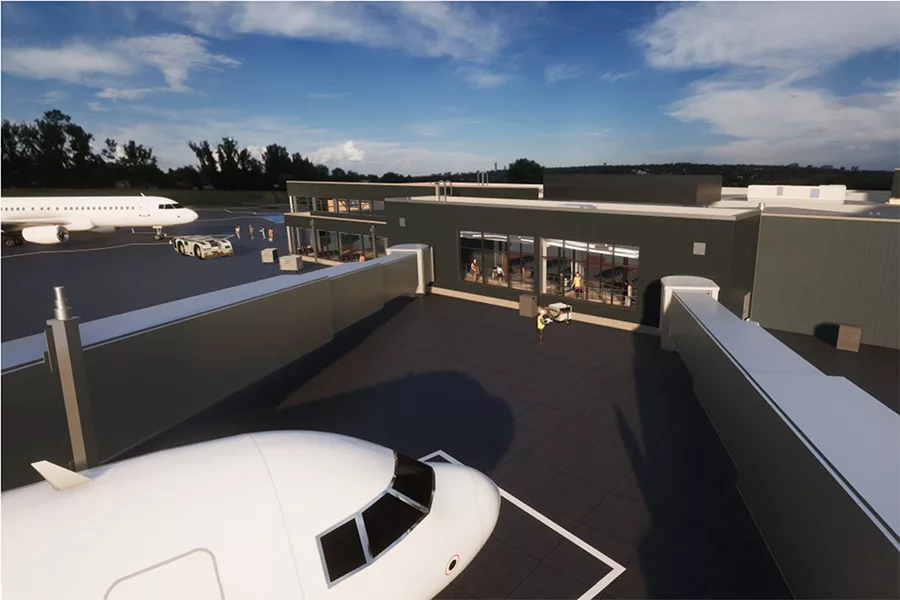
Home » Airport defies national slump, on track for record passenger traffic
Airport defies national slump, on track for record passenger traffic

Proposed jet bridges at some of the Tri-Cities Airport’s gates appear in this rendering of the next phase of expansion at the airport. The project is potentially one of four phases of construction planned at the airport that will cost an estimated $120 million to $145 million and be completed over the next 10 years.
Courtesy Tri-Cities AirportJune 12, 2025
The air travel industry nationwide is experiencing some turbulence but not in the Tri-Cities.
Ticket sales nationally have fallen sharply since February. Airlines are retiring smaller planes in lieu of larger ones due to slowing demand and heightened costs. Many regional airports are shedding capacity as routes that are anything but full become less profitable.
“We are seeing demand weakness,” Jack Penning with Volaire Aviation Consulting told the Port of Pasco commissioners during a recent meeting. “The post-Covid boom wasn’t going to last forever.”
And yet, the Tri-Cities Airport continues to buck each of those trends and more.
Passenger traffic continues to climb each month and is on track to break the annual record at the end of this year. Routes that previously used smaller planes are now using bigger aircraft and filling nearly every seat. And the airport’s flight capacity is double what it was a decade ago.
All this makes it crucial for the Tri-Cities Airport to continue growing its reputation as a lucrative and modern facility.
“We’re competing against some airports with incredible incentives and markets,” Buck Taft, the airport’s manager, told commissioners during the meeting. “I don’t think we need to right now but eventually we will have to invest more in incentives.”
Currently, six airlines offer 22 daily flights to 10 cities from the Pasco airport. With the exception of the travel slowdown during the 2020 Covid-19 pandemic, it has seen steady growth in demand for flights, with just under half a million passengers leaving from its gates in 2024.
Penning’s report detailed how the Tri-Cities Airport stacks up against other airports across the Pacific Northwest, and it’s more than holding its own. PSC fills nearly 85% of the seats on its flights, higher than the industry average of 83%. Only Sea-Tac and the airport at Idaho Falls fill more seats on average in the region.
Tri-Cities Airport also retains 38% of the passengers in its estimated service area, better than Sea-Tac’s 36%, Portland’s 11% and Spokane’s 9%.
“We’re seeing incredible demand for our airport, buoyed by our economy,” Penning said. “We’re actually pulling customers from Yakima and Walla Walla, who have lost 50% capacity.”
But that doesn’t mean the airport is immune to the broader trends affecting the industry. The post-Covid travel boom, characterized by Penning as YOLO, or “you only live once” travel, has faded, especially as economic uncertainty and inflation become big factors. Those impacts also have led corporations, including government contractors, to cut back on business travel.
The tariffs imposed on exports by the Trump administration also add to the costs of building and maintaining aircraft, as 80% of airplane components are made overseas, Penning said. That’s led airlines to halt plane orders, retire planes early, cut routes and potentially raise airfares. The status and future of the tariffs is unclear, as they were recently blocked by the U.S. Court of International Trade, with the Trump administration planning to appeal.
For now those concerns aren’t stopping the airport’s current and future efforts to expand and improve service. The port awarded a $13 million contract for the first phase of its latest expansion project to Richland-based Fowler Construction. The work includes the expansion of the baggage area for outbound baggage and improvements at two gates, among other features.
Taft iterated to commissioners that securing a nonstop flight to Dallas-Ft. Worth remains a top priority, and he anticipates having an update on that effort in the next 18 to 24 months. He acknowledged, though, that there’s stiff competition among airports to keep flights, if not add them.
“I know one airport that is trying to secure Dallas-Ft. Worth, and they have $3.6 million. We have $850,000,” he said.
Penning said there’s plenty of other opportunities for the airport to seek flights to other destinations, based on data showing where those departing the Tri-Cities ultimately end up. San Diego and Chicago are among them.
More than 60 people a day depart the Tri-Cities for Honolulu. That may seem like a stretch for the Tri-Cities, Penning said, but may not be completely out of the question given Alaska Air’s recent acquisition of Hawaiian Air.
Local News Transportation
KEYWORDS June 2025
Related Articles
Related Products





